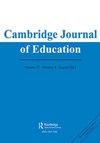Conceptualisations and implications of ‘newness’ in education outside the classroom
IF 1.5
3区 教育学
Q2 EDUCATION & EDUCATIONAL RESEARCH
引用次数: 1
Abstract
ABSTRACT Newness was a key theme identified in a comprehensive national study of education outside the classroom (EOTC) in Aotearoa New Zealand. This paper examines what newness means from the perspectives of students, educators and school leaders. Findings reveal that newness in EOTC was valued because of the difference to everyday routines, as well as to students’ learning and positive emotions; it also deepened students’ understanding of the wider world, and their place in it. Consumption of newness occurred when educators and students framed EOTC through new locations because the potential for learning was quickly ‘used up’. Newness also potentially undermined learning for some students because of discomfort and fear. The authors encourage educators and students to engage in the process of understanding newness in EOTC in order to harness the learning opportunities of both familiar and unfamiliar experiences.课堂外教育中“新性”的概念化及其含义
摘要新性是新西兰奥特亚罗阿一项关于课堂外教育的全国性综合研究中确定的一个关键主题。本文从学生、教育工作者和学校领导的角度考察了“新”的含义。研究结果表明,EOTC的新颖性之所以受到重视,是因为它与日常生活以及学生的学习和积极情绪不同;它还加深了学生对更广阔世界的理解,以及他们在世界中的地位。当教育工作者和学生在新的地点构建EOTC时,就会产生对新鲜感的消费,因为学习的潜力很快就被“耗尽”了。对于一些学生来说,由于不适和恐惧,新鲜感也可能会影响他们的学习。作者鼓励教育工作者和学生参与EOTC中理解新事物的过程,以利用熟悉和陌生经历的学习机会。
本文章由计算机程序翻译,如有差异,请以英文原文为准。
求助全文
约1分钟内获得全文
求助全文
来源期刊

Cambridge Journal of Education
EDUCATION & EDUCATIONAL RESEARCH-
CiteScore
5.30
自引率
4.30%
发文量
35
期刊介绍:
Cambridge Journal of Education publishes original refereed articles on all aspects of education, with a particular emphasis on work that contributes to a shared understanding amongst academic researchers, theorists, practising teachers, policy-makers and educational administrators. The journal also welcomes the submission of systematic review articles that summarise and offer new insights into specific areas of educational concern. With a wide international readership, Cambridge Journal of Education publishes contributions drawn from different educational systems and cultures enabling continued in-depth discussion of global educational theory, policy and practice. The journal’s Special Issue programme encourages and stimulates focused discussion and engagement with significant themes and responses to topics raised by readers and contributors. Cambridge Journal of Education welcomes proposals for future editions.
 求助内容:
求助内容: 应助结果提醒方式:
应助结果提醒方式:


